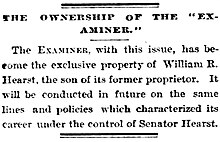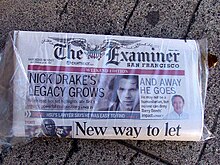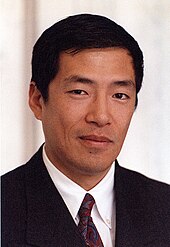The San Francisco Examiner

 Clash Royale CLAN TAG#URR8PPP
Clash Royale CLAN TAG#URR8PPP
| Type | Daily newspaper |
|---|---|
| Format | Tabloid |
| Owner(s) | San Francisco Media Company LLC, Oahu Publications Inc., Black Press Group Ltd. |
| Publisher | Jay Curran |
| Editor | Gregory D. Andersen |
| Founded | 1863, as Democratic Press 1865 as The Daily Examiner |
| Headquarters | 835 Market St., Suite 550 San Francisco, California 94103 |
| Circulation |
[1] |
| Website | www.sfexaminer.com |
The San Francisco Examiner is a daily newspaper distributed in and around San Francisco, California, published since 1863.

First edition, January 12, 1865

Announcement that William Randolph Hearst has become owner of the newspaper, March 4, 1887

San Francisco Examiner front page, Friday, February 27, 1942

The Examiner
The longtime "Monarch of the Dailies" and flagship of the Hearst Corporation chain, the Examiner converted to free distribution early in the 21st century and is owned by the San Francisco Media Company LLC. The San Francisco Examiner was sold to Black Press Group, a Canadian media publisher, in 2011.[2] As of 2014, The San Francisco Media Company LLC is held under, Oahu Publications Inc., a subsidiary of Black Press Group Ltd.[3][4]
Contents
1 History
1.1 Founding
1.1.1 Hearst acquisition
1.2 20th century
1.3 21st century
1.3.1 Fang acquisition
1.3.2 Anschutz acquisition
1.3.3 Independent ownership
2 Editions
3 See also
4 References
5 External links
History
Founding
The Examiner was founded in 1863 as the Democratic Press, a pro-Confederacy, pro-slavery, pro-Democratic Party paper opposed to Abraham Lincoln, but after his assassination in 1865, the paper's offices were destroyed by a mob, and starting on June 12, 1865, it was called the Daily Examiner.[5][6][7]
Hearst acquisition
In 1880, mining engineer, entrepreneur and US Senator George Hearst bought the Examiner. Seven years later, after being elected to the U.S. Senate, he gave it to his son, William Randolph Hearst, who was then 23 years old. The elder Hearst "was said to have received the failing paper as partial payment of a poker debt."[8]
William Randolph Hearst hired S.S. (Sam) Chamberlain, who had started the first American newspaper in Paris, as managing editor[7] and Arthur McEwen as editor, and changed the Examiner from an evening to a morning paper.[5] Under him, the paper's popularity increased greatly, with the help of such writers as Ambrose Bierce, Mark Twain, and the San Francisco-born Jack London,[9] and also through the Examiner's version of yellow journalism, with ample use of foreign correspondents and splashy coverage of scandals such as two entire pages of cables from Vienna about the Mayerling Incident;[7] satire; and patriotic enthusiasm for the Spanish–American War and the 1898 annexation of the Philippines. William Randolph Hearst created the masthead with the "Hearst Eagle" and the slogan Monarch of the Dailies by 1889 at the latest.
20th century

Hearst Building, San Francisco
After the great earthquake and fire of 1906 destroyed much of San Francisco, the Examiner and its rivals — the San Francisco Chronicle and the San Francisco Call — brought out a joint edition. The Examiner offices were destroyed on April 18, 1906,[10] but when the city was rebuilt, a new structure, the Hearst Building, arose in its place at Third and Market streets. It opened in 1909, and in 1937 the facade, entranceway and lobby underwent an extensive remodeling designed by architect Julia Morgan.[11]
Through the middle third of the twentieth century, the Examiner was one of several dailies competing for the city's and the Bay Area's readership; the San Francisco News, the San Francisco Call-Bulletin, and the Chronicle all claimed significant circulation, but ultimately attrition left the Examiner one chief rival — the Chronicle. Strident competition prevailed between the two papers in the 1950s and 1960s; the Examiner boasted, among other writers, such columnists as veteran sportswriter Prescott Sullivan, the popular Herb Caen, who took an eight-year hiatus from the Chronicle (1950–1958), and Kenneth Rexroth, one of the best-known men of California letters and a leading San Francisco Renaissance poet, who contributed weekly impressions of the city from 1960 to 1967. Ultimately, circulation battles ended in a merging of resources between the two papers.
For 35 years starting in 1965, the San Francisco Chronicle and Examiner operated under a Joint Operating Agreement whereby the Chronicle published a morning paper and the Examiner published in the afternoon. The Examiner published the Sunday paper's news sections and glossy magazine, and the Chronicle contributed the features. Circulation was approximately 100,000 on weekdays and 500,000 on Sundays. By 1995, discussion was already brewing in print media about the possible shuttering of the Examiner due to low circulation and an extremely disadvantageous revenue sharing agreement for the Chronicle.[12]
In its stylebook and by tradition, the Examiner refers to San Francisco as "The City" (capitalized), both in headlines and text of stories.
San Francisco slang has traditionally referred to the newspaper in abbreviated slang form as "the Ex" (and the Chronicle as "the Chron").
21st century
Fang acquisition

Ted Fang
When the Chronicle Publishing Company divested its interests, the Hearst Corporation purchased the Chronicle. To satisfy antitrust concerns, Hearst sold the Examiner to ExIn, LLC, a corporation owned by the politically connected Fang family, publishers of the San Francisco Independent and the San Mateo Independent.[13] San Francisco political consultant Clint Reilly filed a lawsuit against Hearst, charging that the deal did not ensure two competitive newspapers and was instead a generous deal designed to curry approval. However, on July 27, 2000 a federal judge approved the Fangs' assumption of the Examiner name, its archives, 35 delivery trucks, and a subsidy of $66 million, to be paid over three years.[14] From their side, the Fangs paid Hearst US$100 for the Examiner.
On February 24, 2003, the Examiner became a free daily newspaper, printed Sunday through Friday.[citation needed]
Anschutz acquisition
On February 19, 2004, the Fang family sold the Examiner and its printing plant, together with the two Independent newspapers, to Philip Anschutz of Denver, Colorado.[13] His new company, Clarity Media Group, launched The Washington Examiner in 2005 and published The Baltimore Examiner from 2006 to 2009. In 2006, Anschutz donated the archives of the Examiner to the University of California, Berkeley Bancroft Library, the largest gift ever to the library.[15]
Under Clarity ownership, the Examiner pioneered a new business model[16] for the newspaper industry. Designed to be read quickly, the Examiner is presented in a compact, tabloid size without story jumps. It focuses on local news, business, entertainment and sports with an emphasis on content relevant to local readers. It is delivered free to select neighborhoods in San Francisco and San Mateo counties, and to single-copy outlets throughout San Francisco, San Mateo, Santa Clara, and Alameda counties, California.
By February 2008, the company had transformed the newspaper's examiner.com domain into a national hyperlocal brand with local websites throughout the United States.[17]
Independent ownership
Clarity Media sold the Examiner to San Francisco Newspaper Company LLC in 2011. The company's investors included then-President and Publisher Todd Vogt, Chief Financial Officer Pat Brown, and David Holmes Black.[citation needed] Early, incorrect media reports stated that the paper was purchased by Black's company Black Press.[18] In 2014, Vogt sold his shares to Black Press.[citation needed] Present-day owners of the Examiner also own SF Weekly, an alternative weekly, and previously owned the now-shuttered San Francisco Bay Guardian.[19]
Examiner columnist Stuart Schuffman, also known as Broke-ass Stuart, was a candidate for Mayor of San Francisco in The City's 2015 mayoral election.[20][21]
Editions
In the early 20th century, an edition of the Examiner circulated in the East Bay under the Oakland Examiner masthead. Into the late 20th century, the paper circulated well beyond San Francisco. In 1982, for example, the Examiner's zoned weekly supplements within the paper were titled "City, "Peninsula," "Marin/Sonoma" and "East Bay."
Additionally, during the late 20th Century, an edition of the Examiner was made available in Nevada which, coming out in the morning rather than in the afternoon as the mothership San Francisco edition did, would feature news content from the San Francisco edition of the day before ~ For instance, Tuesday's news in the Nevada edition that came out on Wednesday ~ but with dated non-hard news content ~ comic strips, feature columnists ~ for Wednesday.
See also
- San Francisco Chronicle
- The Washington Examiner
C.H. Garrigues, jazz columnist
Herb Caen, columnist, 1950–58
Ernest Thayer, humor columnist, 1886–88- San Francisco newspaper strike of 1994
Edgar Orloff, assistant managing editor
References
^ "The Examiner Media Kit" (PDF). The San Francisco Examiner (Press release). 2015. Retrieved October 20, 2017..mw-parser-output cite.citationfont-style:inherit.mw-parser-output qquotes:"""""""'""'".mw-parser-output code.cs1-codecolor:inherit;background:inherit;border:inherit;padding:inherit.mw-parser-output .cs1-lock-free abackground:url("//upload.wikimedia.org/wikipedia/commons/thumb/6/65/Lock-green.svg/9px-Lock-green.svg.png")no-repeat;background-position:right .1em center.mw-parser-output .cs1-lock-limited a,.mw-parser-output .cs1-lock-registration abackground:url("//upload.wikimedia.org/wikipedia/commons/thumb/d/d6/Lock-gray-alt-2.svg/9px-Lock-gray-alt-2.svg.png")no-repeat;background-position:right .1em center.mw-parser-output .cs1-lock-subscription abackground:url("//upload.wikimedia.org/wikipedia/commons/thumb/a/aa/Lock-red-alt-2.svg/9px-Lock-red-alt-2.svg.png")no-repeat;background-position:right .1em center.mw-parser-output .cs1-subscription,.mw-parser-output .cs1-registrationcolor:#555.mw-parser-output .cs1-subscription span,.mw-parser-output .cs1-registration spanborder-bottom:1px dotted;cursor:help.mw-parser-output .cs1-hidden-errordisplay:none;font-size:100%.mw-parser-output .cs1-visible-errorfont-size:100%.mw-parser-output .cs1-subscription,.mw-parser-output .cs1-registration,.mw-parser-output .cs1-formatfont-size:95%.mw-parser-output .cs1-kern-left,.mw-parser-output .cs1-kern-wl-leftpadding-left:0.2em.mw-parser-output .cs1-kern-right,.mw-parser-output .cs1-kern-wl-rightpadding-right:0.2em
^ Temple, James (2011-11-12). "SF Examiner to be sold to Black Press Group". The SF Chronicle. Retrieved 2016-05-22.
^ Eskenazi, Joe (2014-05-06). "Todd Vogt, San Francisco Print Media Company President, Likely to Sell SF Weekly, Bay Guardian, Examiner". The SF Weekly. Retrieved 2016-05-22.
^ Dudnick, Laura (2014-07-02). "New publisher named for San Francisco Media Co". SF Examiner. Retrieved 2016-05-22.
^ ab Hart, James David (1978). A Companion to California. New York: Oxford. p. 441 – via Google Books.
^ "How Old Is The Examiner?". pjsf.typepad.com. Archived from the original on 2004-06-01.
^ abc San Francisco: The Bay and its Cities. New York: Hastings House. WPA Federal Writers' Project. 1940. p. 153. OCLC 504264488 – via Internet Archive.
^ "William Randolph Hearst, Journalist, Dies at 85". The New York Times. Associated Press. May 15, 1993.
^ "William Randolph Hearst, 1863-1951". zpub.com.
^ 1906 quake FAQ Archived 2006-04-14 at the Wayback Machine., Chinatown Historical Society
^ Images of the Hearst Building, San Francisco, California, by Julia Morgan
^ Mandel, Bill (March 1, 1995). "The Case For One Daily". SF Weekly.
^ ab Bryer, Amy (February 19, 2004). "Anschutz buys San Francisco newspapers". Denver Business Journal.
^ Seyfer, Jessie (July 27, 2000). "Judge clears way for Hearst to buy San Francisco Chronicle". Honolulu Star-Bulletin. Associated Press – via starbulletin.com.
^ Maclay, Kathleen (April 4, 2006). "Bancroft Library receives vast archives of San Francisco Examiner". Berkeley.edu (Press release). University of California, Berkeley. Retrieved October 20, 2017.
^ Robertson, Lori (April–May 2007). "Home Free". American Journalism Review. Retrieved 2007-04-18.
^ Harden, Mark (February 27, 2008). "Anschutz's Clarity Media names online chief, recruits new editors". Denver Business Journal. Retrieved October 20, 2017 – via Bizjournals.com.
^ Torres, Blanca (November 11, 2011). "San Francisco Examiner Sold to Black Press Group". San Francisco Business Times. Retrieved October 20, 2017 – via Bizjournals.com.
^ Dudnick, Laura (July 2, 2014). "New publisher named for San Francisco Media Co". The San Francisco Examiner. Retrieved 25 April 2017.
^ Eskenazi, Joe (2014-05-06). "Todd Vogt, San Francisco Print Media Company President, Likely to Sell SF Weekly, Bay Guardian, Examiner". SF Weekly. Retrieved 2014-10-15.
^ Dudnick, Laura (2014-07-02). "New publisher named for San Francisco Media Co". The San Francisco Examiner. Retrieved 2014-10-15.
External links
San Francisco Examiner website
Guide to the Fang Family San Francisco Examiner photograph archive, circa 1930-2000, at The Bancroft Library